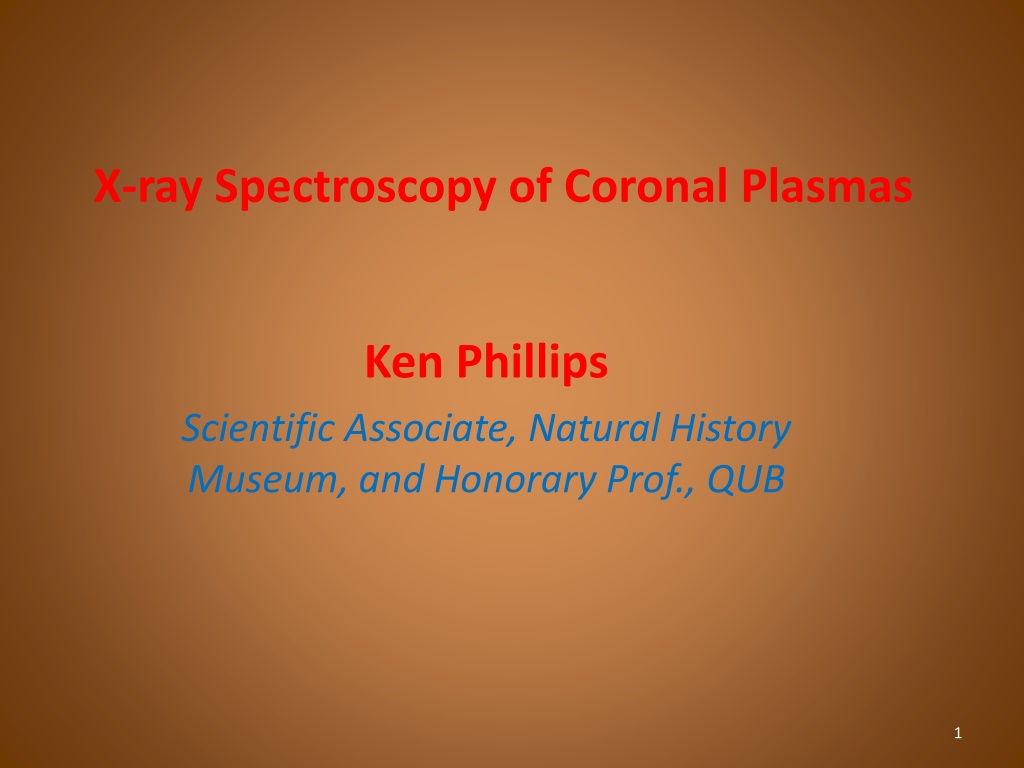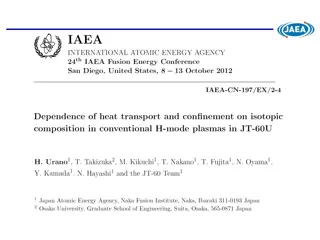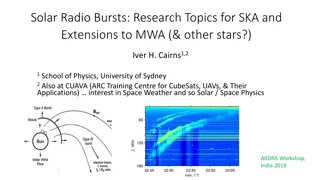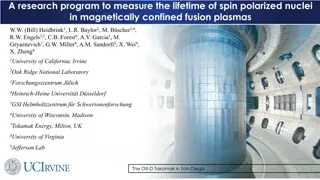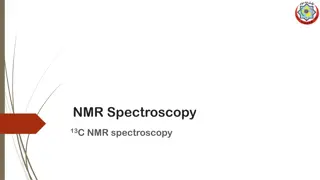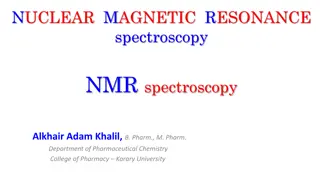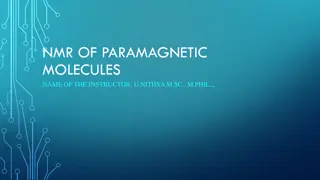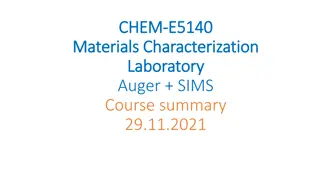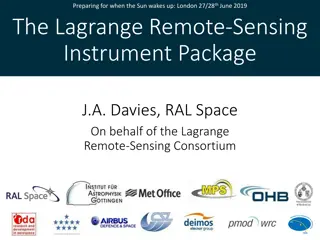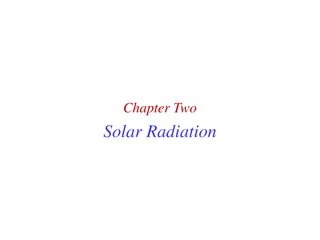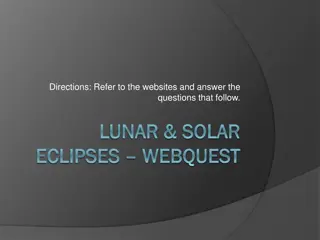Understanding X-ray Spectroscopy of Coronal Plasmas in the Solar Corona
Explore the physical properties and ionization conditions of coronal plasmas as revealed through X-ray spectroscopy in the solar corona. Discover how high temperatures and ionization stages impact the equilibrium of elements like Fe, shedding light on the complex nature of these ionized gases. Unveil the fractions of Fe ionization stages in coronal equilibrium and delve into the intricacies of ionization and recombination processes within this fascinating environment.
Download Presentation

Please find below an Image/Link to download the presentation.
The content on the website is provided AS IS for your information and personal use only. It may not be sold, licensed, or shared on other websites without obtaining consent from the author. Download presentation by click this link. If you encounter any issues during the download, it is possible that the publisher has removed the file from their server.
E N D
Presentation Transcript
X-ray Spectroscopy of Coronal Plasmas Ken Phillips Scientific Associate, Natural History Museum, and Honorary Prof., QUB 1
Solar Corona: Physical Properties Solar corona has very high temperatures:106 K 2 106 K (1 2 MK) far higher than photosphere/chromosphere. Densities are low:n (particles m-3) ~ 3 1014 m-3 near chromosphere down to ~ 2 1012 m-3 at 2 solar radii (Rs ) from Sun s centre. Temperature and density are much enhanced over active regions: T ~ 4 MK and n ~ 1017 m-3. Flare plasmas: formed immediately after a magnetic reconnection event in active regions: T ~ 20 MK and n~ 1018 m-3. Last from minutes to many hours. Reduced density and temperature and open magnetic fields at poles, particularly at solar minimum: coronal holes. 2
Corona is a fully ionized gas or plasma Because of the high temperature, corona is practically a fully ionized gas (or plasma). Nearly all H and He atoms are fully stripped. So particles are almost entirely protons, particles (He nuclei), and free electrons. Heavier elements have very small abundances compared with H or He but are most important as radiators of X-ray line emission. (Soft) X-rays are here defined to be in the spectral range 0.1 nm to 10 nm (1 to 100 ). 3
Ionization conditions in coronal plasmas Coronal plasmas have relatively low densities and high temperatures. Most elements are therefore in the form of ionized atoms in most cases multiply ionized. There is an equilibrium in coronal plasmas (assuming that they are steady-state) between ionizations and recombinations coronal (ionization) equilibrium. 4
Coronal Equilibrium Take the case of Fe ions Fe is one of the most abundant elements after H and He (only C, N, O and Ne are more abundant). For the quiet corona, assuming T=1-2 MK), Fe is in the form Fe+10 to Fe+14(i.e. 10 to 14 electrons removed from the neutral atom state). What determines which are the most abundant ion stages? 5
AR Fractions of Fe ionization stages in coronal equilibrium corona Fractions of Fe ions as a function of T (plotted logarithmically) Ion notation: 9 = Fe+9 19 = Fe+19 etc. Note: for corona, Fe+9 to Fe+14 are abundant ionization stages Mazzotta et al. (1998 A&A) 6
Coronal Equilibrium ionization/recombination Notation: e- stands for free electron, X an element (e.g. Fe) and X+q an ion of element X with q electrons missing. Ionization (rate coefft. Ce) is by collisions with free electrons: e1- + X+q X+q+1 + e1- + e2- (e1- loses energy, imparting it to ion) Recombination (rate coefft. Rr ) occurs by radiative processes: e1- + X+q+1 X+q + h (h = photon, removes excess energy) and by dielectronic processes (rate coefficient RD): e1- + X+q+1 (X+q)** (** = doubly excited ion) 7
Excitation of X-ray line emission Because of the relatively low densities and high temperatures of coronal plasmas, most ions are in their ground state. One of the most intense lines in the solar X-ray spectrum is due to 16-times ionized Fe (Fe+16) at 1.5012 nm. In spectroscopic notation, this is the Fe XVII 1.5012 nm line (Fe XVII = 17thspectrum of Fe ). This line (like most others) is excited from the ground state of Fe+16 by collisions with free electrons to an outer orbit followed by spontaneous de-excitation back to the ground state. 8
Fe+16 (Fe XVII) 1.5012 nm line excitation Ground state of Fe+16 is 1s2 2s2 2p61S0 A collision of a free electron with the ion takes one of the 2p electrons to a 3d state: 1s2 2s2 2p5 3d 1P1 The lifetime of this state is extremely short (roughly 2 x 10-13 s); normally this state spontaneously de-excites to the ground state, with the emission of the 1.5012 nm line: Fe+16 (1s2 2s2 2p61S0)+ e- Fe+16 (1s2 2s2 2p5 3d 1P1) + e- Fe+16 (1s2 2s2 2p61S0)+ h where h = hc / corresponds to = 1.5012 nm. 9
X-ray resonance lines The Fe XVII 1.5012 nm line is an example of an X-ray resonance line the line is formed by an allowed transition from an excited state of Fe+16 to the ground state. The solar X-ray spectrum is dominated by other resonance lines emitted by other elements. H-like and He-like ions feature prominently e.g. O VIII Ly- (1.897 nm), O VII lines (2.160 nm) being examples of lines emitted by H-like O and He-like O ions. 10
X-ray Spectrum of decaying solar flare Flare observed by Solar Max FCS instrument, August 25, 1980 11
Dielectronic Satellite Lines in the X-ray Spectrum of the Sun In the solar X-ray spectrum, we observe lines that are excited by hot active regions or flares temperatures range from ~ 4 MK (non-flaring active regions) up to ~ 20 MK (flares). We can use lines formed in the dielectronic recombination process satellite lines to get the temperature of such plasmas. Satellite lines are so called because they occur just to the long- wavelength side of associated resonance lines. The ratio satellite/resonance line depends on 1 / electron temperatureTe. The satellite line intensity depends strongly on the ion s atomic number Z (= constant Z 4). 12
Satellite line/resonance line int. ratios Based on Gabriel (1972 MNRAS)13
Solar flare spectra of Fe XXV lines and Fe XXIV satellites Te=15.0 MK: Satellites intense compared with Fe XXV resonance line w. Te=17.5 MK: Satellites weaker compared with Fe XXV line w. 14 Lemen et al. (1984 A&A)
Electron densities from X-ray line ratios Electron densities Ne are more difficult to obtain from X-ray lines but if a pair or group of lines from the same ion exist, the ratio of line intensities can sometimes depend on Ne. Consider a 3-level diagram for an ion, with ground level 1, metastable m, and another excited level 3. Metastable means that this level has a relatively long lifetime, with small transition probability to the ground state. Suppose the transition 3 1 is allowed (i.e. has a high transition probability). Collisional excitation (rate coefficient C*) from level m to 3 can compete with radiative de-excitation m 1 if the density is high enough. If so, Nm Am1 ~ Nm NeC* and the line intensity ratio I(m 1) / I(3 1) depends on Ne. 15
Level diagram for a 3-level ion or atom Line 3 1 is allowed, line m 1 is forbidden . Level 3 NmNeC* (collisional excitation) m (metastable) N3A31 NmAm1 (spont. de-excitn.) 1 Ground level (1) 16
Density sensitivity of lines of He-like O (O VII lines at 2.2 nm) Plot of density- sensitive ratio R = ratio of a forbidden line to intercombination line against Ne in cm-3 (multiply by 106 to get m-3). 17
Observations of O VII lines during a solar flare observed by the P78-1 spacecraft (1980) Max. density (~1018 m-3) Decreasing densities Low-density spectra Doschek et al. (1981) 18
X-ray continua Continua are evident in particularly solar flare spectra. They are chiefly due to free-free and free-bound transitions. With crystal spectrometers (the usual instrument to observe solar X-rays), the continuum is sometimes difficult to distinguish from background. With the RESIK spectrometer on the Coronas-F mission, the continuum is seen at wavelengths less than 0.43 nm (4.3 ) but instrumental background predominates at longer wavelengths. 19 B. Sylwester et al. (2004, IAU)
Other diagnostics Spectral lines (not necessarily coronal emission lines) can give information about mass motions, e.g. flows of gas or plasma. This is done through the Doppler shifts of spectral lines. In solar flares, X-ray lines indicate huge upflowing plasma flows at the flare onset phase, velocities of several hundred km/s. Spectral line profiles are often broadened beyond the thermal Doppler width, suggesting plasma turbulence. This occurs in the quiet Sun, active regions, and particularly flares. 20
Spectral line profiles Spectral lines can be broadened by several mechanisms. If the coronal gas has a Maxwell-Boltzmann distribution of ions, the observed line width (full width at half maximum flux, FWHMobs) due to thermal Doppler broadening is: / 1 2 / 1 2 2 2 k T k T = = . 1 = / 1 prob v 2 FWHM 2 ln 2 2 ln 2 665 ion ion B B obs c c m c m ion ion where line wavelength = , c = vely. of light, vprob= most probable thermal speed of the ion, Tion is the ion temperature, mion = ion mass. 21
X-ray lines showing flare short-wavelength shifts Spectra of the Ca XIX resonance line at 0.318 nm (3.18 ) at four times during a large solar flare: note short- wavelength component to each spectral line.
Summary The solar corona is a fully ionized gas with T = 1-2 MK (~4MK in active regions, up to 20MK in flare plasmas). There is strong X-ray emission in the form of lines and continuum. Lines are due to allowed and forbidden transitions in the ions of trace elements (e.g. O, Ne, Fe). Which ions are predominant is determined by a coronal ionization equilibrium. Lines are excited by electron collisional processes; resonance lines most intense. Dielectronic recombination gives rise to satellite lines the intensities of which give temperature information. There are a few density-sensitive lines they indicate Ne ~ 1018 m-3 at the maximum of flare plasma development. X-ray spectral line profiles indicate plasma turbulence in flares accompanied by upflows of a few hundred km/s. 23
